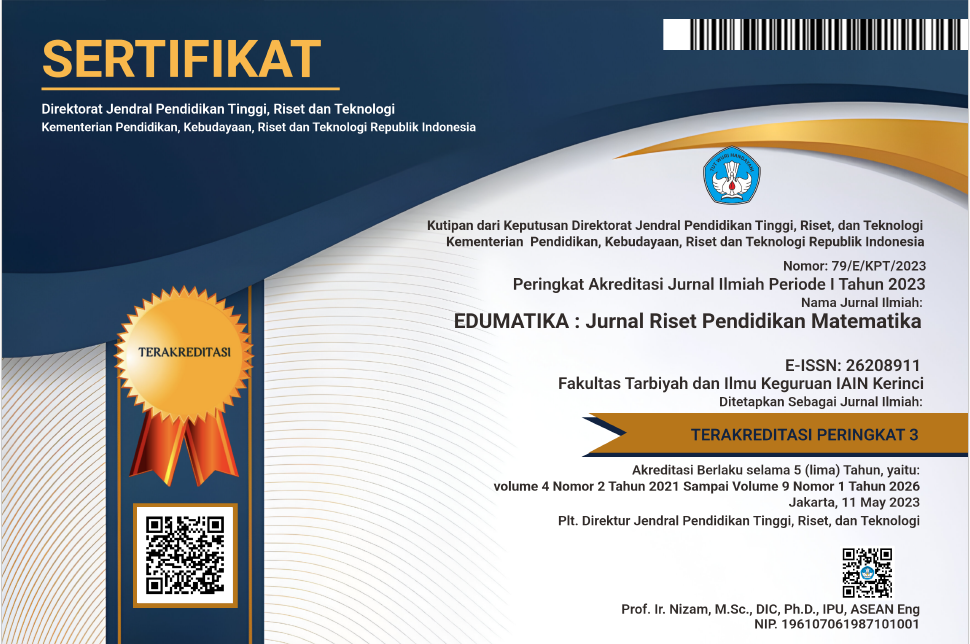Analisis Koneksi Matematis Siswa dalam Menyelesaikan Soal Setara TIMSS Ditinjau dari Locus of Control
Abstract
This study aims to describe the students’ mathematical connections in terms of the locus of control. The mathematical connection indicators in this study are writing down the mathematical concepts that underlie the answers, recognize the relationship of various mathematical ideas and mathematical topics that can be related to problems of everyday life, and understand how to solve mathematical ideas that are interrelated and underlie each other to obtain an integrated whole. Data collection methods in this study were questionnaires, tests, and interviews. The subjects of this study were six seventh-grade students at MTs Negeri 7 Jember. The data analyzed by qualitative descriptive analysis. Based on the tests and interviews analysis, we known that students with internal locus of control could write mathematical concepts as a two variable linear equation system (TVLES). Students can connect TVLES material with problems, for example, represented the object in variables x and y. Students can also solved the problems related to TVLES material by using common examples, elimination and substitution methods. While the students’ with external locus of control also can write the mathematical concepts as a TVLES. But the students did not write in detail the relationship between TVLES material and the problem. Students can not solve problems by using TVLES solutions such as elimination and substitution, but students only use estimates in finding solutions.
Downloads
References
Baki, A., Çatlioǧlu, H., Coştu, S., & Birgin, O. (2009). Conceptions of High School Students About Mathematical Connections to the Real-Life. Procedia - Social and Behavioral Sciences, 1(1), 1402–1407. https://doi.org/10.1016/j.sbspro.2009.01.247
Bishara, S., & Kaplan, S. (2018). The Relationship of Locus of Control and Metacognitive Knowledge of Math with Math Achievements. International Journal of Disability, Development and Education, 65(6), 631–648. https://doi.org/10.1080/1034912X.2018.1432033
BNSP. (2013). Kerangka Dasar dan Struktur Kurikulum Sekolah (Issue Standar Penilaian Pendidikan, 1–234). https://doi.org/10.1017/CBO9781107415324.004
Farida, E., Alauzi, F. A., & Zanthy, L. S. (2018). Analisis Koneksi Matematis Siswa dan Kepercayaan Diri Siswa SMP. Journal On Education, 1(4), 688–695.
Habibi, M., Darhim, D., & Turmudi, T. (2018). Self-Determination in Mathematics Learning Process by Using Generative Multi–Representation Learning (GMRL) Model. In Journal of Physics: Conference Series, 1097(1), 012155
Kenedi, A. K., Helsa, Y., Ariani, Y., Zainil, M., & Hendri, S. (2019). Mathematical Connection of Elementary School Students to Solve Mathematical Problems. Journal on Mathematics Education, 10(1), 69–80.
Keta, D. P. (2018). Analisis Interaksi Gender dan Locus of Control Serta Pengaruhnya terhadap Professional Judgement. Jurnal Akuntansi, 6(1), 1–17.
Konan, N. (2013). Relationship between Locus of Control and Problem-Solving Skills of High School Administrators. International Journal Social Science & Education, 3(3), 786–794.
Lee, C., Ashford, S. J., & Bobko, P. (1990). Interactive Effects of “Type A” Behavior and Perceived Control on Worker Performance, Job Satisfaction, and Somatic Complaints. Academy of Management Journal, 33(4), 870–881. https://doi.org/10.5465/256296
Malinda, P., & Minarti, E. D. (2018). Pengaruh Self Confidence Terhadap Kemampuan Koneksi Matematis Siswa SMP. Jurnal Pendidikan Tambusai, 2(6), 1829–1837.
NCTM. (2000). Principles and Standards for School Mathematics (I. Mullis & M. Michael (eds.)). Key Curriculum Press.
Ni’mah, A. F., Setiawani, S., & Oktavianingtyas, E. (2017). Analisis Kemampuan Koneksi Matematika Siswa Kelas IX A MTs Negeri 1 Jember Subpokok Bahasan Kubus dan Balok (The Analysis of Mathematic Connection Capability Grade IX A MTs Negeri 1 Jember Subchapter Cube and Block). Jurnal Edukasi, 4(1), 30–33.
Nurafni, A., & Pujiastuti, H. (2019). Analisis Kemampuan Koneksi Matematis ditinjau dari Self Confidence Siswa: Studi Kasus Di SMKN 4 Pandeglang. ANARGYA: Jurnal Ilmiah Pendidikan Matematika, 2(1), 62-67.
Özgen, K. (2013). Self-Efficacy Beliefs In Mathematical Literacy And Connections Between Mathematics And Real World: The Case Of High School Students. Journal of International Education Research (JIER), 9(4), 305. https://doi.org/10.19030/jier.v9i4.8082
Rotter, J. B. (1966). Generalized expectancies for internal versus external control of reinforcement. Psychological monographs: General and applied, 80(1), 1.
Schultz, D. P., & Schultz, S. E. (2009). Theories of Personality. Wadsworth Cengage Learning.
Susanto, A. (2013). Teori Belajar dan Pembelajaran di Sekolah Dasar. Prenamedia Group.
TIMSS. (2017). TIMSS 2019 Assessment Frameworks. TIMSS & PIRLS International Study Center.















